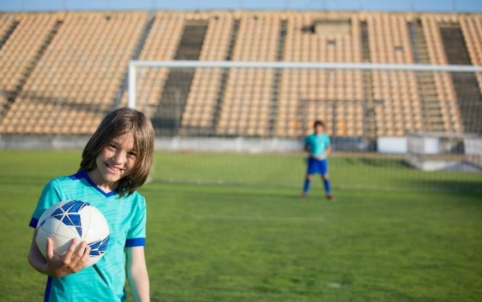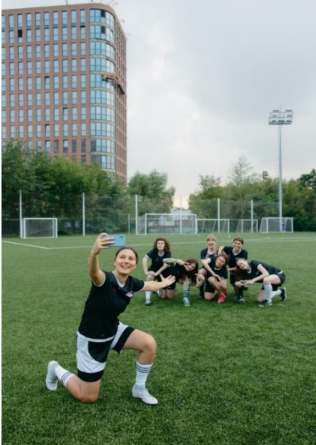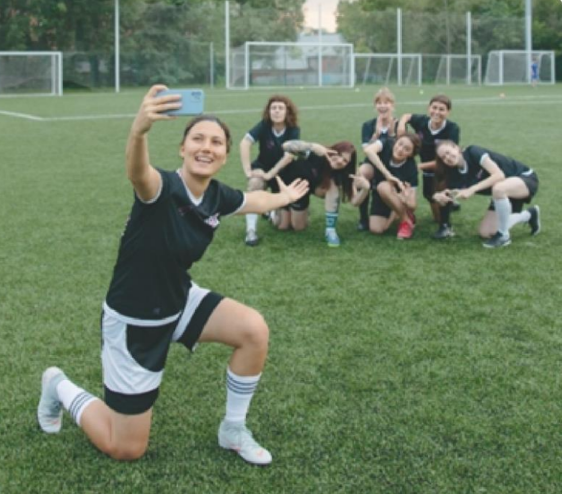Media coverage, promotion, marketing and visibility of women in football
Understanding
Women’s sport has been largely under-represented in the past. This has been particularly the case with women’s football, but things are gradually changing. Since the first international events were held, including the first Women’s World Cup in 1991, women’s football has seen a positive development in terms of the number of players and media visibility.

With more than 750 million viewers watching the FIFA Women’s World Cup in Canada in 2015, media interest in the game has increased by 33% compared to the 2011 World Cup in Germany. This growth was also seen in 2019 with 993.5 million viewers, 30% more than in 2015.
According to FIFA, these figures make the Women’s World Cup the second most watched competition on television after the FIFA World Cup.

Beyond that, the internet and social media have taken on a full role in the dissemination of women’s sport. According to FIFA data, there has been a marked
increase in its visibility, with several records being broken. The 2015 edition thus recorded¹ :
- 20 million unique visitors to FIFA.com for the FIFA Women’s World CupTM pages, 225 million page views and 7.8 billion seconds spent on the site
- 178% more daily visitors on FIFA.com for the FIFATM Women’s World Cup pages compared to 2011
- 130% more followers for the FIFATM Women’s World Cup Facebook Page (up to 662,000 followers)
- 81% more followers for the @FIFAWWC Twitter account (up to 222,000 followers)
- 37% more followers for FIFA’s Instagram account (up to 1.37 million followers)
- 9 billion Tweets mentioning the FIFA Women’s World CupTM
One of the highlights was the record monthly audience in June 2015 on the YouTube channel (28 million views), a figure higher than that of the 2014 Men’s World Cup (19 million views in June 2014).
The 2019 figures confirm this increase in visibility and the growing public interest in women’s practice. According to FIFA, “Based on survey research carried out by Nielsen on behalf of FIFA, it is estimated that 481.5 million people accessed coverage of the Women’s World Cup on Digital Platforms, equivalent to 41.8% of the Total Audience Reach. This was up from an estimated 86 million in 2015″²
¹ Key figures for ‘Canada 2015’, in FIFA.com
² FIFA Women’s Wolrd Cup France 2019TM , Global Broadcast and Audience Report, 2019.

Even if women’s visibility remains low compared to men’s in the football arena, it is clear that there has been a certain transformation of the game. Without
overlooking the other dimensions that contribute to the development of women’s football, we can see here the importance, but also the necessity of communication in the feminisation of football. Communication is an important aspect of the development of women’s football, both in terms of publicising the sport and attracting the interest of potential players and the public.
Actors have several choices of media. Despite the audience possibilities offered by traditional media such as television, radio or newspapers, it also appears that
they leave little room for women footballers and, above all, focus on high-level practice. They are therefore useful and can be used by players whenever they have
the opportunity. In the face of this limited access, social media now appear to be essential supports for the dissemination of women’s sport at all levels.
Indeed, with 4.5 billion active users of networks, i.e. nearly 54% of the world’s population3, the impact of social media and other digital platforms is no longer in doubt. If digital is currently an important lever for sports communication, it is even more so for women’s sport in general and women’s football in particular.
Despite this increase in interest in women’s football, there are still many disparities compared to men and media coverage, sponsorship, marketing and visibility are still limited.
The E-WinS survey conducted in several European countries provides an understanding of the issues and position on gender equality, the opportunities offered by social media as well as good practices and ways to improve the media coverage, promotion, marketing and visibility of women’s football.
[3] “We are social and Hootsuite – Digital 2021”.
Good practices and proposals for improvement
Ensuring gender equality in club media coverage
In the EWinS survey, respondents in the 5 countries were asked to rate from 1 to 5 the extent to which they felt that their current club (or a club including women and men if their club was an all-women’s club) ensured equality between men and women in media coverage. Only 24% of respondents gave a score of ‘5’ (‘extremely equal’) to this question,3 2% gave a score of ‘4’, 42% gave a score of ‘3’, 17% gave a score of ‘2’ and only 12% gave a score of ‘1’ (‘not equal at
all’). Similarly, when asked to what extent respondents felt that women’s football at their current club is favoured over men’s football (or at a club with both women and men, if theirs is an all-women’s club), 24% of respondents answered “3”. A total of 13% answered “1” (“not at all equal”), 12% answered “2”, 22% answered “4” and 20% answered “5”/”extremely equal”.
In the responses, there are some differences between countries which can be linked to their organisational or political context. However, in general, the guarantee of equality between men and women is far from being recognised.
However, the respondents did not restrict themselves to negative findings. They also explored some good practices or areas where media coverage could be improved. The most dominant reference to good practices for media coverage and promotion is directed towards social media, which was mentioned 196 times in all six countries.

Take advantage of the strong social media presence in the visibility and dissemination of women’s football
In our survey, we find that social media occupy a large place. It is one of the good practices mentioned that allows for a lot of dissemination or visibility. The table on the right shows some examples of good practices in each country.
| Country | Examples of good practice in social media |
|---|---|
| Bulgaria | Results, photos and information about the team’s matches are shared. |
| England | Social media will promote and celebrate the Regional Talent Centre and the players. We will use the players as role models on our community session flyers…”. |
| Finland | The club’s promotions always feature players from both the men’s and women’s teams. The online website advertises both teams, and the men’s Instagram details the women’s team. ‘ |
| France | Presence of a media club to cover training at least once a week, media club present at all our matches, media clubs travelling with the team to training, media club to cover the events of the women’s team, regularly updated website and social networks, press contact for the women’s section. ‘ |
| Poland | Well-developed social media (up to date information, trivia, interviews, post- match commentary), announcement of entries, selection consultations, tests, awareness of parents/fans of the essence of women’s football. ‘ |
| Spain | CAP Ciudad de Murcia broadcasts both teams (men and women) on Twitter. ‘ |
While television also allows for the broadcasting or summary of matches, interviews or articles, the same promotion is done on social networks. It is interesting to note, however, that the broadcasting of live matches on television is mentioned as a good practice, as is radio.

Improve media coverage, promotion and visibility of women in their clubs
In terms of how to improve media coverage, three categories of proposals were frequently mentioned and were well defined by the respondents with examples, namely
- “Raising profiles” this is defined by the survey participants as the need to talk about women’s football in a more positive tone (e.g. “getting people interested and attracting more and more girls”.
- “Greater circulation”: i.e. greater coverage and knowledge of women’s football (e.g. “That people learn more about women’s football, that it becomes more visible and that it gradually evolves” – Spain).
- “Broadcasting matches”: this refers to any reference to helping women’s football reach a wider audience through televised and/or streamed matches (e.g. “Broadcasting women’s matches, fixtures etc.” – England).
To improve promotion, recommendations are proposed which fall into two broad categories in terms of “individual responsibility of individuals and clubs” and “organisational and structural responsibility”.
With regard to the “individual responsibility of people and clubs”, some examples of good practice are cited: In cases where there were both men’s and women’s teams within a club, there was a preference to join the women’s team in order to have a presence on the men’s team’s website, rather than develop a women-only website. For example, one Finnish and one French participant, respectively, stated:
“Could be published on an equal basis between the women’s and men’s teams. When the women’s team was established, our team was promoted everywhere
and more like the men, because our team was the first women’s team with us.”
(Finland)
“We must follow the example of HAC (Le Havre Athletic Club)! Women in the same boat as the boys. A men’s team and a women’s team, with a common communication”.
(France)
On these websites, the promotion of individual players through interviews with them and coaches, in addition to advertising matches and publishing match statistics, was reported as a preferred method of improving promotion. A Bulgarian participant commented on this point by stating:
“In my current club, everything depends on the management to promote its activities. Maybe a website with profiles of competitors and staff, live broadcasting, regular interviews before and after matches and detailed match statistics would be useful, but this requires a lot of resources which are difficult to organise and support as a cost of any women’s club in the country.
(Bulgaria)
In France and England, the need to regularly update the content of website platforms was also mentioned. To achieve this, the majority mentioned the usefulness of having dedicated staff to promote women’s football and regularly updated online material, as one English participant explained his club’s good practice in this area: …the press officer for the men’s team regularly attends the women’s games and takes a close interest in the progress of the women’s and girls’
teams.
With regard to “organisational and structural responsibility”, it is mentioned for example: improve revenue, prioritise youth development; equlity between men and women, promote positive women role models, etc.
These different aspects of media coverage, promotion or visibility in clubs depend on whether women’s clubs are integrated into men’s clubs or are independent. Integration is seen as desirable, in terms of media coverage and marketing, where elements such as match statistics, match publicity and interviews to promote players, are seen as beneficial when incorporated into the existing web pages of men’s or general clubs. But there are also some advantages to keeping the women’s team separate, with separate marketing sometimes seen as beneficial.
The research confirms this dual position by seeing integration as desirable to enhance the professionalism, visibility and commercialisation of the women’s game. (Aoki et al., 2010; Valenti et al., 2018) on the one hand. On the other hand, there are benefits to keeping the women’s game separate. (Caudwell, 2011; Welford, 2018; Woodhouse et al., 2019). For example, being integrated, the women’s team might have to comply with the decision-making powers of the men’s team, which might force it to be financially dependent on it… (Welford, 2018).
One of the improvements suggested by survey respondents is the need for dedicated media or marketing staff. In many women’s clubs, there is not always a dedicated person to do this work, so players are forced to take responsibility for publications and relaying information to promote themselves and remain visible.
All of the good practices or improvements proposed may be useful and/or adapted to different contexts depending on the configuration of the club and the policies of its country.



